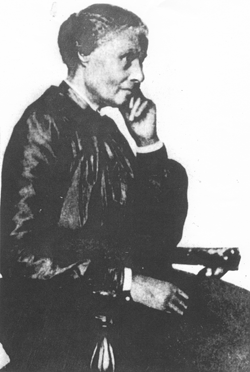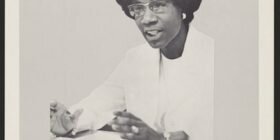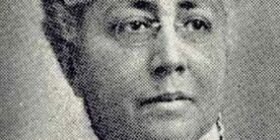Ask A Heroine: Welcome to the experts corner, love. This is where you ask your burning questions on business and life, and receive personal advice from the best. Each month we feature amazing industry Heroines and their wise video answers to your deepest inquiries. Here, questions give way to solutions, insights transform into action, and more »
Heroine of History: Annette Abbott Adams – Justice for All
Heroines of History: These are American women, and their actions were not motivated by fortune or fame. There was no glory, and in many cases very little recognition for their activities. They simply did what needed to be done, and they did so in an extraordinary way. They roared without making a sound and it is time that they were given a voice. Annette Abbott Adams we hear you.
Annette Abbott was born on March 12, 1877 in Prattville, CA. Her mother, a school teacher from Maine, placed a high importance on her children’s education, and therefore would bring her children to Chico every fall so that they could attend school. She felt that a girl’s education was just as important as a boy’s, so she made sure that both of her daughters attended as well as her son. Annette’s father had come to California from Ohio in the hope of striking it rich during the gold rush. Failing in this venture, he was able to carve out a good business with a country store and also served as justice of the peace. Annette spent much of her free time either helping her father in the store, or reading through the law books that he had accumulated. So when her father died when Annette was only 12, her older sister, stayed home to take over the household chores with their younger brother taking over the outdoor tasks including tending the animals, and Annette helped her mother run the store. In this capacity, she turned to her father’s law and code books to give her mother legal advice so that they wouldn’t be taken advantage of since there was no longer a man running the business.
As Annette came of age, she received a teaching certificate from the Chico State Normal School. Annette majored in history and economics and was especially intrigued by the campaign that Susan B. Anthony waged in California in 1896 trying to pass a women’s suffrage amendment. Anthony’s attempt failed, but a spark had been lit in Annette. She taught grammar school for four years, and saved what money she could so that she would be able to attend the University of California at Berkeley. Annette did just that, and in 1904 she graduated with a Bachelor of Letters degree in law. However, as a woman, who didn’t even have the right to vote, she was unable to find work in law and so fell back on her old profession of teaching.
She was hired on to teach history and economics at a high school in Alturas, Modoc County. As Annette ventured into the social circles of Alturas she realized that a large number of the doors being slammed in her face were not because she was a woman, but because she was an unmarried woman. So much to the surprise of everyone that knew her, Annette married Martin Houston Adams in August of 1906. Breaking with tradition, Annette continued to teach and in 1907 she was appointed as the principal of Modoc County High School, making her the first female school principal in California. With her new position, and status as a married woman, Annette was welcomed in social circles and became friends with a suffragette name Iva Spencer Raker, whose husband, John Raker, happened to be a local judge. Impressed with her intelligence and work, Judge Raker convinced Annette to return to school to get her doctorate in law. In 1910, she returned to school, leaving her husband behind when she left. They never divorced, but they also never lived together again, fueling rumors that she had indeed married solely to get a Mrs.
While she was in school the suffrage amendment was finally passed, so that when she graduated in 1912 with a J.D. from Boalt Hall at UC Berkeley she was not only able to vote, but able to practice law as well. Annette was admitted to the state bar shortly after graduation, and when Western Pacific Railways went to the dean at Boalt Hall and asked for their best man to head up their legal department, the dean told them that his best man was actually a woman, Annette Adams. Scoffing at the idea of hiring a woman, the railways hired the dean’s second best man. Not allowing herself to be deterred Annette practiced law as she could in Plumas County, and hired a vocal instructor to learn how to change her soprano voice to a lower, more authoritative tone.
That was when John Raker, now a US Congressman, stepped back into Annette’s life. Raker persuaded her to join the campaign for Woodrow Wilson’s run for the presidency. She moved to San Francisco and became the president of the Women’s State Democratic Club. Annette tirelessly organized women voters and stumped for Wilson, an advocate for women’s rights. Her efforts paid off, and Adams was invited to Washington D.C. in 1913 to celebrate Wilson’s victory. While in D.C. Congressman Raker introduced her to influential contacts in the hopes of securing her a job as a reward for her hard work on the campaign. Alas, this came up dry and Adam’s took a leisurely sight-seeing route back to California.
Once back, Annette started a practice with a colleague Marguerite Ogden, who was the daughter of a judge. Their practice was met with much derision and even the newspapers took turns mocking them. Despite the opposition, their practice soldiered on, and against all odds their clientele was composed mostly of men, not women as their adversaries had predicted. It was in 1914, when Adams was defending a man who had been charged with violating the Mann Act – bringing a female over state lines for immoral purposes – that she attracted the attention of US Attorney John Preston. He was so impressed with her work that he offered her a job. Thus Annette Adams became the first female federal prosecutor. She served in this role, winning several large cases, until 1918 when she was promoted to the role of US Attorney in San Francisco, becoming the first woman to serve as a US Attorney. Adams developed a name for herself by ruthlessly prosecuting wartime food hoarders and those charged of seditious acts. However, despite the fact that she was not a proponent of prohibition herself, it was her prosecution of those that violated the Volstead Act that garnered her national attention.
This work, helped by the lobbying of Congressman Raker, saw Adams appointed as the first female Assistant US Attorney General. She moved to Washington D.C. where Adams was responsible for the overseeing of the federal prison system – prison labor, treatment of prisoners, etc. – but her main focus was once again the prosecution of violators of the Volstead Act. Annette flourished in this work, however like so many other political appointees, she found herself out of a job when newly elected President Harding took office.
Annette returned to San Francisco where she practiced law with her old colleague John Preston. Despite her impressive resume, Adams had trouble finding work unless it was under the guidance of a male attorney. When Preston left for a seat on the California Supreme Court, Annette took what cases she could get and managed the San Francisco cases of attorney Jesse W. Carter, who practiced in Redding. Over the years she won important water and public utility cases as well as the infamous “Painless Parker” case against the flamboyant street dentist of the same name. In 1923, she ran for a seat on the San Francisco Board of Supervisors and lost. For the first time not because she was a woman, but because she didn’t have the support of the labor workers due to her Prohibition prosecutions.
1932 found Adams once more embroiled in politics as she campaigned for Franklin D. Roosevelt. She developed women’s clubs in Northern California and organized women voters. After his election, Roosevelt offered her a position on the Federal Board of Tax Appeals. However, wanting to stay in California, she turned the offer down. Instead Adams campaigned for an opening on the federal bench of the northern district in California. Despite the support that she had from Democratic leaders, colleagues and women voters, the appointment went to a male candidate. As a consolation Roosevelt appointed her the Assistant Special Counsel of US Oil Litigation, where she got to work once more with John Preston.
Annette moved to Los Angeles where she worked from 1935 – 1939 on two major cases. The first was to restore two sections of the Elk Hills Naval Oil reserve No. 1 to the federal government and the second was to secure compensation from Standard Oil and other smaller companies for the oil that they had extracted. After four long years they won both the land claim and a judgment that Standard Oil owed more than 7 million dollars. This figure was reduced on appeal, but it was still a momentous win for both Preston and Adams.
After her return to San Francisco, California Governor Culbert Olson appointed Adams as the Presiding Justice of the Court of Appeal, 3rd Appellate District. This not only made Annette one of the four highest ranking judges in the state, but it also made her the first female appellate court justice in California. Adams won an election of a 12 year term and while sitting on the bench wrote over 350 opinions. In 1950, she served by special appointment on one case in the California Supreme Court making her the first woman to serve as a California Supreme Court Justice. Sadly, Annette was unable to finish out her 12 year term due to increasingly poor health caused by arteriosclerosis. She retired in 1952 to her home in Sacramento where she lived quietly until her death on October 26, 1956.
Annette Abbott Adams this is in your honor. Thank you for all that you did.
Comments
comments








No comments yet.